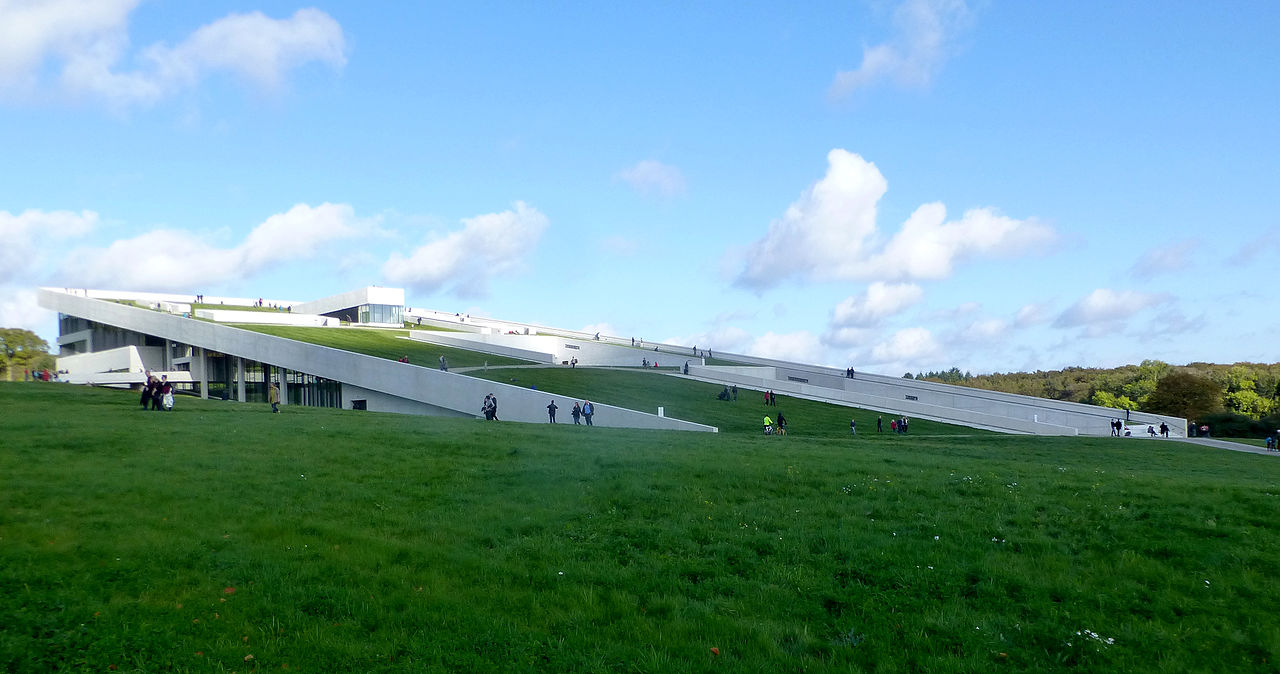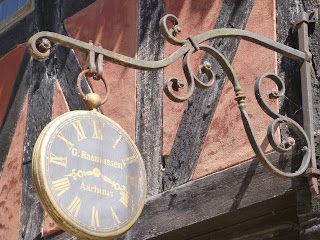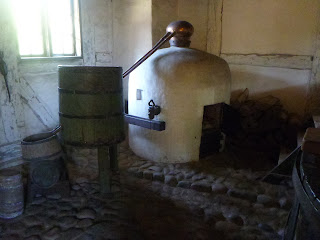23. Aarhus - Den Gamble By and Moesgaard Museum
Breakfast
was not included in the Hotel price, something I don’t like but must have
overlooked when I booked this hotel. Ah, there are shops across the street, no
biggie; we went to McD…yep, why not…we sure ate enough on our trip.
 |
| A Street of Workshops Rented to Tradesmen |
It
was cumbersome to take a few buses from our hotel to the museum so we decided to
use our car, it worked out ok, we used the parking wheel, we made sure we
parked properly, etc. It still is a bit
of a guessing game, can we park here or not, but in Denmark it seems a lot
easier to park.
 |
| Candle Maker Shop |
Our
morning exploration was of an open air museum called ‘Den Gamble By’ that has been in
operation since 1914. It is a good museum. We were there when the place opened up
for the day and spent a good 3 hours walking through the, mostly oldest section,
of the exhibition; the section covering the years 1550 to 1864.
 |
| Glass Maker |
They
have other sections from between 1864 to1927 and then from 1927 to 1974 but
those were not as interesting to me. There are some staff members of
 |
| Preacher But No Church Here Yet |
the museum
who walk around in period regalia. We met the town’s pastor and had our lunch
in the town bakery. All the shops were open and we were free to explore nooks
and crannies. Horse and carriages made their rounds, a man was playing his musical
instrument, and another few apprentices were just running through the streets,
looking busy.
 |
| Accordion Player by the River's Edge |
 |
| Girls Doing the Wash |
 |
| Young Girl Eating Porridge That the Woman at the Stove Has Cooked |
A
rather large group of high school youngsters, in period dress, had chores to
do. The boys were chopping wood, sweeping the streets with a whisk broom,
collecting kindling or stacking wood.
 |
| Bakery |
Some
girls were doing the wash by hand in the outside mews; some were inside cooking
the mid-day meal on a working wood stove. Visitors like us were given
stew for
lunch, Carol had some and said it was very good, but the young adults only
received porridge for their meal. In their role play, they were all orphans and
to recreate the true conditions at the time; porridge was what orphans
received, while the Gentry had stew. I hope those students learned something
from that.
Since
we had squandered our money on the cookies we ate, we had had our lunch and
Carol in addition had her stew… so no lunch.
 |
| Entrance to the Moesgaard Museum |
After
all this walking we were glad to be sitting in the car but we were not done
with Aarhus. In Aarhus there is one of the best, modern museums for the Viking
age. But better for me was the view this museum offered between the Stone and
Bronze Ages. The museum is named Moesgaard, and it’s simply fantastic.
The
landscape around the museum contains recreational ‘buildings’ we did not even
have time to visit. It would take a week to see it all.
I came to see the ‘Grauballeman’, a
mummified man found in a bog. He was a sacrifice to the gods long ago.
Grauballeman
 |
| Face of the Bogman |
We
could not get a really good picture of this mummy from around 300 BC, so I stole this picture from
the Museum website. The Bogman died when his throat was slashed at about 30 years of age.
But
when I entered the museum there was so much more to see, it boggled my mind.
What Carol and I liked the most were the statues on the staircase; Life-like
representations of ‘people’ throughout Earth’s history. It is a progression of
development from Lucy to the present Homo Sapiens. Just fascinating!
 |
| Tiny, Life-Sized Lucy at the Top of the Staircase |
Lucy (40% of her skeletal structure) was discovered in 1974 in Ethiopia. Lucy was 1.1 m (3 ft. 7 in.) tall, weighed 29 kg (64 lb.) and after reconstruction looked somewhat like a chimpanzee. The creature had a small brain like a chimpanzee, but the pelvis and leg bones were almost identical in function to those of modern humans, showing with certainty that Lucy's species were hominids who stood upright and walked erect. Her remains were dated to 3.5 million years ago, making her one of the earliest pre-human hominid found.
The
museum had excellent sections, dealing with life as it was during the Stone Age
(12,500 to 7000 BC) and the explanation of how those people wandered north and
settled down and established themselves in today’s Denmark, after the
 |
| Masks |
last Ice
age receded. The exhibits followed the Iron Age up to the Bronze Age (1700 to 500
BC). And then concentrated more on the regional development of Denmark between
the years 500 BC to 800 AD.
It was fantastic; we spent most of our time in this section.
This
museum concentrates on the ‘belief’ system the people had at that time, too. The
Gods they prayed to, the mystery of death, the sacrifices those people offered
to appease those who caused them grief. It was a really, really different world
then.
 |
| The Gundestup |
And
if that was not enough, then there was the Gundestup, a large cauldron found
in Denmark. Lots of stories circulate as to why this ‘cup’ was so large. It was not
really a cup and what was found was really incomplete so we don’t know for sure
but here is one story I liked.
Before
battle, the shaman would brew a concoction and then pour it into this bowl. The
warriors would ‘drink’ from this elixir, touch the cup so to speak and then go
out and fight. I bet there was more than just beer in the brew of the shaman.
The fighters who drank from this cup felt no pain it was said.
 |
| Inside Gundestup at the Bottom |
Well,
we just touched the cauldron, we never drank from it, but I love this story.
We
also just touched upon the town of Aarhus and the museums; we never really
drank the local beer, ate the local food or walked the local streets.
The
exhibit of the dead reminded me what I have seen in Mexico.
The
time from 1050 to 1536 is a blur to me now. I cannot recall this exhibit.
The
‘Black Death’ that arose in 1350 alone would need weeks to explore.
There
is so much more one can do especially at the Moesguaard. But we wanted to see the roof of this
building, too.
We
took the elevator up to the roof, the view was astounding. This building in
itself was an exhibit, not just what was in it. Built in 1970, the museum
building was planned well and it is a one of a kind place.
 |
| The Museum From the Same Side as the Entrance |
Standing
at the top of this slant you can see the Sea.
We
drove back to the hotel, very impressed. We were so tired however, we did not
even go for dinner, I just bought a sandwich across the street and we ate in the
room.
Good Night!

























































